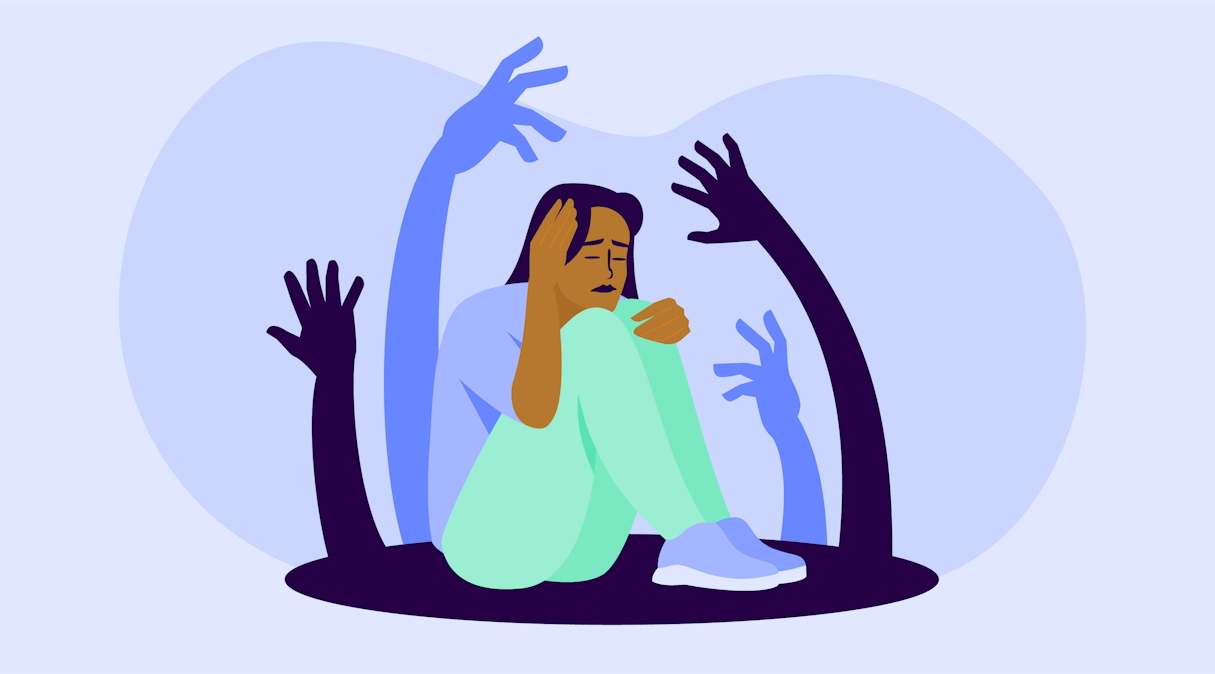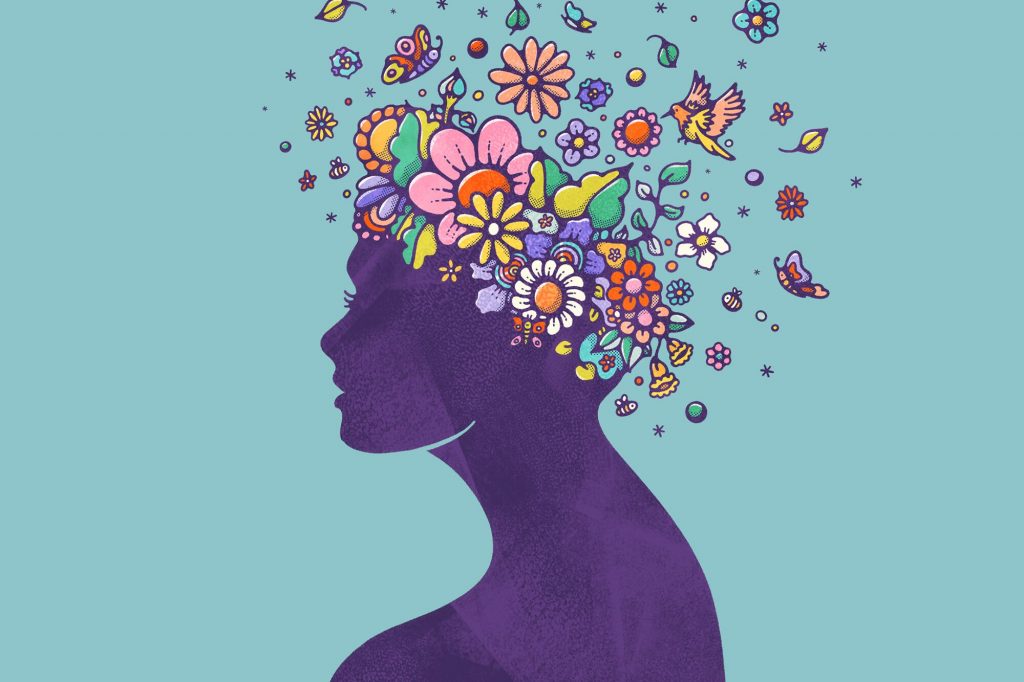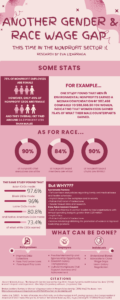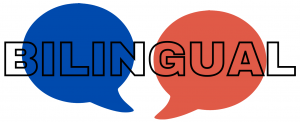Have you, or someone you love, ever had an episode of fear so intense you thought the world was ending? What you were likely experiencing is called a panic attack. They are sudden episodes of anxiety that cause painful physical sensations that often lead to feelings of impending doom. Panic attacks often cause a rush of hormones such as cortisol, adrenaline, and norepinephrine to flood the body 1. These hormones cause the physical symptoms associated with panic attacks. Unfortunately, panic attacks can happen to anyone at any time. Due to their unpredictable nature, it is important to recognize and understand the signs.
Some common symptoms of a panic attack are:
- Hyperventilation
- Excessive sweating
- Chest pain
- Increased heart rate
- Shaking
- Numbness in hands
- Thought spirals
- Fear of dying
- Increased sensitivity

Everyone who goes through a panic attack experiences it differently. The time frame and symptoms vary per person. On average, panic attacks last somewhere between five to twenty minutes with symptoms hitting their peak in the beginning. After the attack dissipates, self care is very important because some of the symptoms may linger 2.
Possible after effects include:
- Fatigue
- Shakiness
- Feelings of shame or sadness
- Confusion
- Numbness
- Heightened sensitivity
As terrifying as it is to experience a panic attack, there are ways to help overcome the episodes. Trying different coping mechanisms can help you regain control and find your way back to feeling safe and secure. Whether you are experiencing a panic attack or helping a loved one, trying new techniques can make a big difference on the length and severity of the episode.
1. Practice mindfulness
Mindfulness is the practice of focusing your attention to the present tense by interacting with bodily sensations and feelings 3. The 5-4-3-2-1 method is one of the easiest ways to practice mindfulness. To begin, notice five things you can see and list them in your head. Then find four things you can touch or feel. These are less difficult because you can do it with your eyes closed. After, acknowledge three things you can hear. Panic attacks can cause everything to feel loud and overwhelming. Narrowing it down by individual sound can help your body realize that there is no real danger. Finally, find two things you can smell and one thing you can taste. This practice forces the brain to stay in the present, and helps your parasympathetic nervous system to activate a sense of calm 4.
2. Progressive muscle relaxation
Progressive muscle relaxation is an exercise that can be categorized under mindfulness, but is different in certain ways. It is done by honing your focus on different muscles while increasing tension and then letting it go 5. Start by tensing the muscles in your feet for five seconds and then relax them. Notice how the muscles feel after you let the tension go. Do they feel lighter? Calmer? After you take note of your feelings, start working your way up to your calves and so on until you reach your head. Not only does this process help panic attacks, but it is also a useful aid for managing stress and quality sleep. If it feels too overwhelming to focus on different muscle groups, try your best to pick just one. Asking certain questions in regard to the muscle or body part may also help ease discomfort. Example questions are: “how do my feet feel in my socks?” or “how do my arms feel on my clothes?”

3. Breath-work
Breathing is one of the most important ways to calm a panic attack because when the body is in overdrive with cortisol and other stress hormones, hyperventilation often occurs. Hyperventilation is when the body takes in oxygen at a very fast rate. Breathing quickly for too long can cause the levels of carbon dioxide to decrease in the blood which increases panic attack symptoms [5].To combat this, breathe in through your nose and out through your mouth slowly. An easy way to recall this is by the phrase “smell the flowers and blow out the candles”. Focus on the feeling of air filling your lungs and let each breath bring you closer to a balanced state. Box breathing is an effective way to ease hyperventilation and anxiety by breathing in a pattern of fours. For example, breathe for four seconds, hold for four seconds, breathe out for four seconds, and then hold for four seconds 6.
4. Find a Focus Phrase
A focus phrase is a set of words that you can use to pull your attention away from the negative sensations and thoughts that are experienced during a panic attack [5]. A mantra, affirmation, or even a word that holds meaning to you can be a powerful tool in bringing your mind and body back to homeostasis. Some examples are “this will pass” and “breathe in, breathe out”. The process of repetition can serve as a helpful reminder that feelings are temporary 3. No matter how scary or life threatening it may seem, this panic attack will not be the end of your story.
While coping methods are not a substitution for professional mental health treatment, they can help ease the fear and pain associated with the episodes. It is important to note that if you are suffering with panic attacks or any other form of mental distress, help is always available. The phone number for the 24 Hour Crisis/Mental Health and Substance Abuse Helpline is 1-(800)-316-9241 or (210) 223-SAFE(7233). Seeking therapy and professional treatment can be scary, but you are not alone.
- Mayo Clinic. Panic Attacks and Panic Disorder – Symptoms and Causes. Last modified May 4, 2019. https://www.mayoclinic.org/diseases-conditions/panic-attacks/symptoms-causes/syc-20376021. ↵
- MIND. Panic Attacks | Mind, the Mental Health Charity – Help for Mental Health Problems. 2019. https://www.mind.org.uk/information-support/types-of-mental-health-problems/panic-attacks/. ↵
- Mindful Staff. What Is Mindfulness? Last modified July 8, 2020. https://www.mindful.org/what-is-mindfulness/. ↵
- University of Rochester Medical Center. 5-4-3-2-1 Coping Technique for Anxiety. Accessed April 14, 2025. https://www.urmc.rochester.edu/behavioral-health-partners/bhp-blog/april-2018/5-4-3-2-1-coping-technique-for-anxiety. ↵
- MIND. Panic Attacks | Mind, the Mental Health Charity – Help for Mental Health Problems. 2019. https://www.mind.org.uk/information-support/types-of-mental-health-problems/anxiety-and-panic-attacks/panic-attacks/. ↵
- Mayo Clinic. Panic Attacks and Panic Disorder – Symptoms and Causes. Last modified May 4, 2019. https://www.mayoclinic.org/diseases-conditions/panic-attacks/symptoms-causes/syc-20376021. ↵
- Mindful Staff. What Is Mindfulness? Last modified July 8, 2020. https://www.mindful.org/what-is-mindfulness/. ↵




6 comments
rmanzur
This article was incredibly informative and compassionate in its explanation of panic attacks. I appreciated how clearly the symptoms and aftereffects were described, as well as the practical coping strategies like mindfulness and breathwork. The writing was approachable and supportive, offering real comfort to anyone who may be struggling. It’s an important and empowering resource—thank you for sharing it!
Isabella Manion
This was such an inspiring piece! The aftermath of a panic attack is very draining and exhausting, and I appreciate how in-depth this article was. It truly captures the feelings and emotions surrounding panic attacks while they’re happening and how to help preserve and calm oneself afterwards. I’m delighted you took the time to research and write about this, and in doing so, brought light to the struggles people go through, because it’s not always visible, but the struggles are still there. Thank you for writing this, very good work!
TJ
I found the article’s clear breakdown of panic attacks really helpful. I appreciated how it explained the rush of hormones like adrenaline and cortisol and linked them to the physical symptoms we feel. The practical coping techniques felt genuine, especially the 5 4 3 2 1 mindfulness exercise and box breathing method to bring focus back to the present. Noting after effects such as fatigue and confusion made the piece feel honest and relatable. Overall it offered a solid guide for anyone facing those moments.
Micaella Sanchez
I had no idea that going through panic attacks could be so scary. Reading about the symptoms and coping strategies for panic attacks made me reflect on how important it is to recognize the signs of anxiety, not just in myself, but in those around me. It reminded me that taking a few minutes to breathe, ground myself, or offer support to someone in distress can make a difference. This article helped me to remind myself to stay grounded.
Carlos Flores
This was such a powerful and beautifully written piece. I really appreciate how you not only explained the symptoms of panic attacks clearly, but also offered practical, compassionate ways to cope. One thing that really stood out to me was your explanation of how mindfulness, like the 5-4-3-2-1 method, can activate the parasympathetic nervous system—that’s such a fascinating and important detail. Congratulations on creating something that is both educational and incredibly encouraging for anyone struggling with anxiety.
Meadow Ayala
This was such a compassionate and helpful piece. Panic attacks can feel so isolating and terrifying, but this article does an amazing job of breaking down what’s happening in the body and offering real, simple tools for coping. I love how it emphasizes that every experience is different and that healing takes patience and care. It’s comforting to know there are steps you can take in the moment — and that seeking help is a sign of strength, not weakness. Articles like this are so important because they remind people they’re not alone in what they’re feeling.